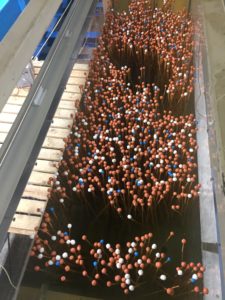Interception, the direct capture of particles by plant stems and leaves in vegetated river systems and wetlands, might play an important role in shaping the landscape’s physical form, ecological communities, and water chemistry. Interception may function as a filter for particle-bound contaminants, and it may play an important role in reversing subsidence and land loss at the coastal margin. However, particle capture rate by “collectors”, a catch-all term for submerged roots, stems, and branches, varies greatly depending on the physical structure of the canopy and its biochemical properties. Experimental methods attempting to bring theory of fluid dynamics to bear on this topic are still being actively developed. One subject of particular recent interest concerns biofilm, the thin layer of algae and other microbiota that live underwater on the surface of plants. In a series of laboratory and field flume experiments, we are building on work recently published by other researchers (e.g., Fauria 2014), to better characterize the empirical properties of sediment capture by plants with and without biofilm and determine mathematical relationships for interception as a function of particle size distribution, water velocity, and vegetation density.
Departments of Geography & Civil and Environ Engineering, UC Berkeley



